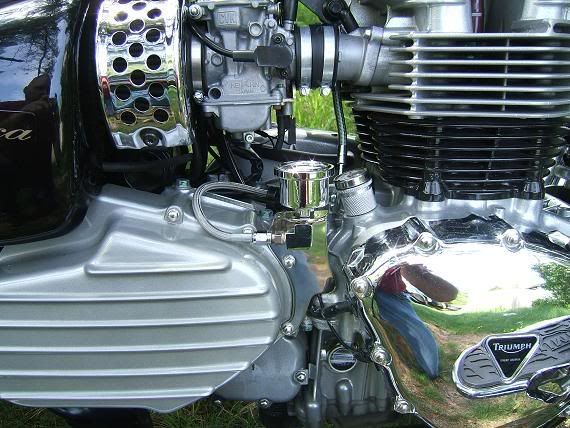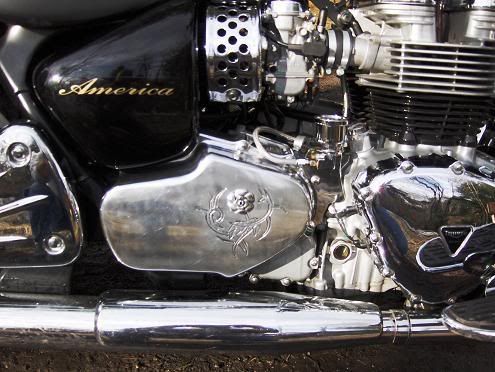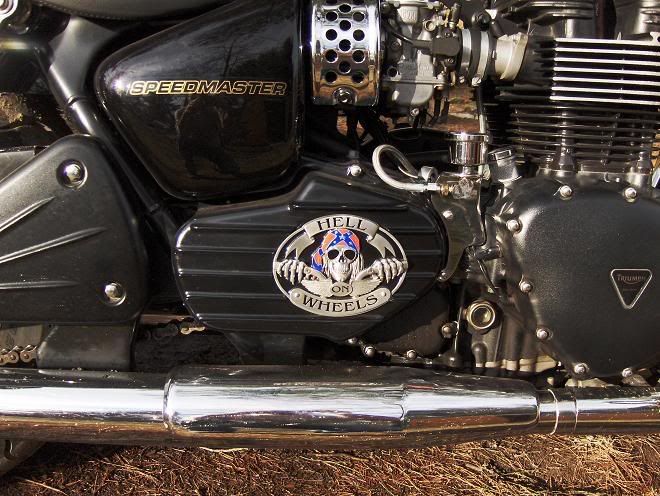tooblekain
750cc
This was an item I have always wanted for my Bonneville but could not for the life of me come to terms to spending close to $200 for the kit. Plus I wanted the satisfaction knowing you spent the time to research and built up something yourself. I finally had some free time between all the trackdays to do my research and find the right parts to make an oil pressure gauge.
I spent approximately $75 plus random parts in the garage; and a little bit of elbow grease to make my own oil pressure gauge that I am completely satisfied with.
I bought a good majority of my parts off Summit Racing (www.summitracing.com)
Here are the parts that I bought from Summit Racing and the prices that I bought them at:
Stainless Steel Braided Hose: Russell Performance Endura 12" Straight -3 to Straight -3 - Street Legal (Part# RUS-656022) $16.96
Double Banjo Bolt: Russell Performance 10mm x 1.25mm Double Banjo Bolt (Part # RUS-40508)--[this will include 3 aluminum crush washers] $6.85
Banjo Fitting: Russel Performance 10mm Banjo x -3 male 90 degree (Part # RUS-R4051C) $5.32
Gauge fitting to hose: Autometer Right Angle Fitting (Part # ATM-3270) $5.25
Liquid-filled oil pressure gauge: There are so many choices out there and its just a matter of your personal taste. Just make sure you get a gauge that measures up to 100psi. I decided to buy my gauge from Amazon because I didn't really like the design of the oil filled pressure gauge that Summit Racing had. However if you fancy it, it is an Accel Liquid Filled Oil Pressure Gauge (Part # ALM-7122). If anyone wants to know where I got my specific gauge, just PM or post on here.
The things I had in my garage for this project:
Exhaust metal strapping (available at most auto parts stores)
Rustoleum Spray paint
various washers and lock washers
a couple copper crush washers
The "Elbow Grease" Part:
I cut a strip of exhaust metal strapping kit to make the bracket to hold the gauge. Once I found the desired length I actually had to make the mounting holes bigger for both the gauge and for the bolt. I simply used a stepped pyramid bit and a drill press to do this. (No problemo)
The next step is what takes patience...I had to figure out a way to bend the strip of metal I cut so it holds the gauge at the desired angle. I used a hammer and anvil to make the bends I wanted. This was a lot of trial and error...but nothing to worry about. I spent about 15 minutes with this. Once I got the bracket to bend how I wanted, I wanted to prevent it from rusting. I grabbed a can of Rustoleum spray paint I had laying in the garage and sprayed the bracket and let it dry overnight.

Once I had all my pieces together, it was time to install everything. To install everything, just follow this youtube video:
http://www.youtube.com/watch?v=fK-TowulAGI
Things to note while installing:
The original banjo bolt on there I believe you need to use a 5/8 wrench or socket. The new double banjo bolt uses a 9/16 wrench. I guess all banjo bolts use SAE
I used a spare copper crush washer I had in my garage that sit between the engine and original oil line...and then used the aluminum crush washers that came with the double banjo bolt for the banjo fitting and top of the banjo bolt.

I wrapped teflon tape around the threads on the gauge, threaded nipple on the banjo fitting, and threaded nipple on the right angle fitting just to make sure I do not have any leaks

The order I had for the gauge and bracket was: flat washer, bracket, locking washer, right angle fitting

Once I had everything in place, I tightened everything down.
Here's how I routed my hose:

If you need pictures for reference, here is the photo album of it all:
https://plus.google.com/photos/1099...s/5704469118461444177?authkey=CMaPrvqrxpiRwgE
Hope this helps and let me know if you have any questions
I spent approximately $75 plus random parts in the garage; and a little bit of elbow grease to make my own oil pressure gauge that I am completely satisfied with.
I bought a good majority of my parts off Summit Racing (www.summitracing.com)
Here are the parts that I bought from Summit Racing and the prices that I bought them at:
Stainless Steel Braided Hose: Russell Performance Endura 12" Straight -3 to Straight -3 - Street Legal (Part# RUS-656022) $16.96
Double Banjo Bolt: Russell Performance 10mm x 1.25mm Double Banjo Bolt (Part # RUS-40508)--[this will include 3 aluminum crush washers] $6.85
Banjo Fitting: Russel Performance 10mm Banjo x -3 male 90 degree (Part # RUS-R4051C) $5.32
Gauge fitting to hose: Autometer Right Angle Fitting (Part # ATM-3270) $5.25
Liquid-filled oil pressure gauge: There are so many choices out there and its just a matter of your personal taste. Just make sure you get a gauge that measures up to 100psi. I decided to buy my gauge from Amazon because I didn't really like the design of the oil filled pressure gauge that Summit Racing had. However if you fancy it, it is an Accel Liquid Filled Oil Pressure Gauge (Part # ALM-7122). If anyone wants to know where I got my specific gauge, just PM or post on here.
The things I had in my garage for this project:
Exhaust metal strapping (available at most auto parts stores)
Rustoleum Spray paint
various washers and lock washers
a couple copper crush washers
The "Elbow Grease" Part:
I cut a strip of exhaust metal strapping kit to make the bracket to hold the gauge. Once I found the desired length I actually had to make the mounting holes bigger for both the gauge and for the bolt. I simply used a stepped pyramid bit and a drill press to do this. (No problemo)
The next step is what takes patience...I had to figure out a way to bend the strip of metal I cut so it holds the gauge at the desired angle. I used a hammer and anvil to make the bends I wanted. This was a lot of trial and error...but nothing to worry about. I spent about 15 minutes with this. Once I got the bracket to bend how I wanted, I wanted to prevent it from rusting. I grabbed a can of Rustoleum spray paint I had laying in the garage and sprayed the bracket and let it dry overnight.

Once I had all my pieces together, it was time to install everything. To install everything, just follow this youtube video:
http://www.youtube.com/watch?v=fK-TowulAGI
Things to note while installing:
The original banjo bolt on there I believe you need to use a 5/8 wrench or socket. The new double banjo bolt uses a 9/16 wrench. I guess all banjo bolts use SAE
I used a spare copper crush washer I had in my garage that sit between the engine and original oil line...and then used the aluminum crush washers that came with the double banjo bolt for the banjo fitting and top of the banjo bolt.

I wrapped teflon tape around the threads on the gauge, threaded nipple on the banjo fitting, and threaded nipple on the right angle fitting just to make sure I do not have any leaks

The order I had for the gauge and bracket was: flat washer, bracket, locking washer, right angle fitting

Once I had everything in place, I tightened everything down.
Here's how I routed my hose:

If you need pictures for reference, here is the photo album of it all:
https://plus.google.com/photos/1099...s/5704469118461444177?authkey=CMaPrvqrxpiRwgE
Hope this helps and let me know if you have any questions
Last edited:






